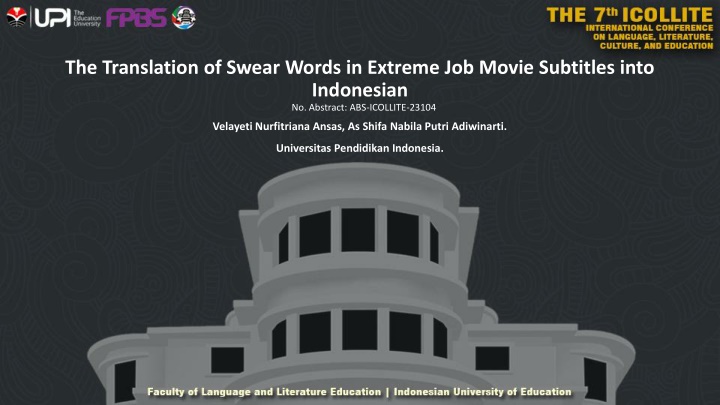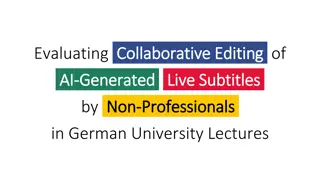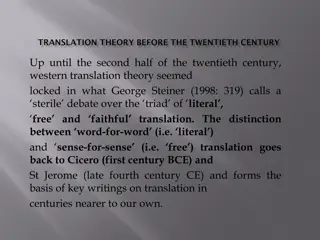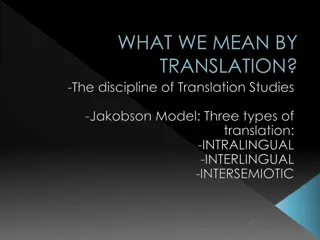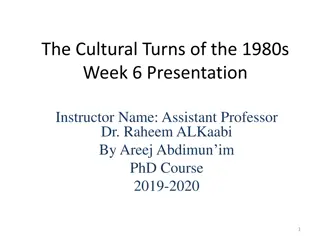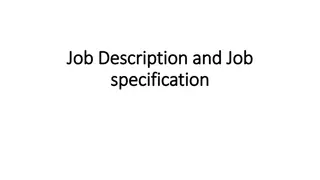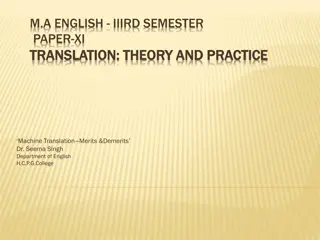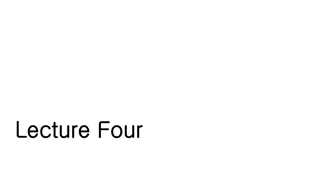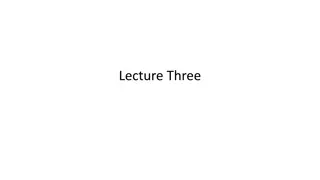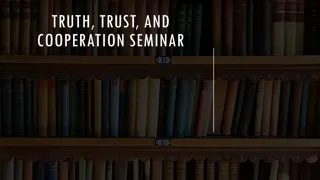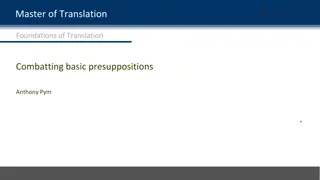Translation of Swear Words in Extreme Job Movie Subtitles
This study delves into the translation techniques used in subtitling swear words from Korean to Indonesian in the movie "Extreme Job". It explores the various forms and functions of swear words while discussing how they are rendered in translation, drawing insights from previous research studies in the field.
Download Presentation

Please find below an Image/Link to download the presentation.
The content on the website is provided AS IS for your information and personal use only. It may not be sold, licensed, or shared on other websites without obtaining consent from the author.If you encounter any issues during the download, it is possible that the publisher has removed the file from their server.
You are allowed to download the files provided on this website for personal or commercial use, subject to the condition that they are used lawfully. All files are the property of their respective owners.
The content on the website is provided AS IS for your information and personal use only. It may not be sold, licensed, or shared on other websites without obtaining consent from the author.
E N D
Presentation Transcript
The Translation of Swear Words in Extreme Job Movie Subtitles into Indonesian No. Abstract: ABS-ICOLLITE-23104 Velayeti Nurfitriana Ansas, As Shifa Nabila Putri Adiwinarti. Universitas Pendidikan Indonesia.
INTRODUCTION Allan and Burridge (2006:76) define that swearing is something to humiliate and criticize the object of insult, as well as using another type of dysphemism. The same thing was expressed by Wijana and Rohmadi (2012:109) who defined swearing as words that are often used by someone to express hatred, anger, displeasure or dissatisfaction with the situation faced by the speaker. According to Chang (2010) in Korean, swear words or yokseol ( ) are usually referred to as sangmal ( ), sangsori ( ), yukdumunja ( ) or yukdam ( ) which mean low and unkind words. Chang (2010) also revealed that swear words in Korean come in four forms, words, phrases, delimiters and sentences. According to Chang (2010) swear words in Korean are divided into two types, namely gibon yokseol and ganghwayokseol. According to Simatupang (2000) translating is transferring the meaning contained in the source language into the target language and regenerating it in the target language in as reasonable forms as possible according to the rules that apply in the target language. Vinay and Dalbernet (1995) divide translation techniques into seven categories. These seven categories are divided into two major groups of translation techniques, direct translation and indirect translation. This study aims to explain swear words in Korean and describes the translation techniques used in the subtitles of a Korean film entitled Extreme Job.
LITERATURE REVIEW 1. Hilpatun, Mus and Habiburrahman (2019) found in their research that The forms of swear words in the comedy drama film Sasak OMJ (Ooo Menu Jarin) found two forms of swear words, namely basic word forms and phrase forms. Functions of swear words contained in the movie is an abusive function, expletive function, humorous function and auxiliary function. 2. Arrasyid, Sajarwa and Astuti (2022) found in their research that In translation swearing from French to Indonesian in the movie Banlieue 13, the most prominent strategy is the taboo for taboo strategy. This is possible because the source language and target language both have a variety of swear words that refer to similar meanings. The translation of swear utterances requires various adaptations so that the resulting translation can be accepted by speakers of the target language. 3. Nurazizah and Usmi (2021) research focuses on discussing swearing Korean into Indonesian and using webtoons as corpus data. In this study, the authors used Chang's theory (2010) to classify swear words in the data and Vinay and Dalbernet's (1995) theory of translation to identify the translation techniques used in translating swear words in Yakhan Yeongung's webtoon. The results showed that there were 28 swear words that appeared in the corpus data studied, namely 15 gibon yokseol and 13 ganghwa yokseol. Among these insults, there are 2 gibon yokseol and 1 ganghwa yokseol which are not translated. Gibon yokseol translated with translation translation, transposition, equivalence and conditions. While ganghwa yokseol is translated by transposition, equivalence, adaptation, deletion and addition.
METHOD This study uses a qualitative descriptive analysis method. The qualitative descriptive research method is a method used by researchers to find knowledge or theory of research at a certain time (Mukhtar, 2013). In this case, the writer uses two data sources. The primary data is in the form of the Extreme Job movie and Indonesian subtitles in that movie, while the secondary data is in the form of a literature review, namely indirect sources related to swear words and translation as references. The first step taken was to watch the Korean movie Extreme Job with Indonesian subtitles. Then, proceed with transcribing the conversation from the Korean source text to the Indonesian target text. Then, identify the data that is the object of research, namely swear words. The third classifies swear words based on Chang's theory (2010). The fourth, analyzing translation techniques based on the theory of Vinay and Dalbernet (1995). Finally, discussion of research results and conclusions.
FINDING AND DISCUSSION The technique that is often used to translate gibon yokseol is the literal translation technique. According to (Vinay Dalbernet in Hatim and Munday, 2004:149) literal translation is a technique of literally translating from the source language into the target language by following the proper grammar and sentence structure. This technique is used to translate one of the swear words that appears in the data, namely jjabsae ( ). Based on the Big Korean Dictionary from the website of the National Institute of Korean Language ( ) Republic of Korea, the swear word jjabsae ( ) has the meaning ' , ' ' ' which means slang for criminals, the term for ' police officers'. In accordance with the original meaning, translation into the target language is also translated with the word 'police' Ganghwa yokseol more often uses deletion translation techniques. In the translation of this type of swearing, usually not only one technique is used, but one technique can also be combined with other techniques.
CONCLUSION In this study, 55 swear words appeared in the Korean film Extreme Job. After being classified using Chang's theory (2010), there are 33 gibon yokseol and 22 ganghwa yokseol. Based on the translation technique proposed by Vinay and Dalbernet (1995) the techniques used to translate gibon yokseol are literal translation (10 swear words), Equivalence (8 swear words), Adaptation (1 swear word) and there are 12 swear words that are not translated. Then, the techniques used to translate ganghwa yokseol are literal translation (4 swear words), adaptation (8 swear words), equivalence (8 swear words), deletion (15 swear words), addition (4 swear words) and there are 6 swear words which not translated.
REFERENCES Allan, Keith and Burride, Kate. (2006). Forbidden Words; Taboo and the Censoring of Language. New York:Cambridge University Press. Arrasyid, N.D., Sajarwa., Astuti, W.T.(2022). Strategi Penerjemahan Ujaran Makian Bahasa Prancis dalam Film Banlieue 13 Karya Pierre Morel. DIGLOSA:Jurnal Kajian Bahasa, Sastra dan Pengajarannya Volume 5 Nomor 1, 31-48. Chang, K.H. (2010). The nature and type of Korean abuses. Textlinguistics, 29(0), 401 427. Hatim, B. & Munday, J. (2004). Translation: An advanced resource book. Routledge. Hilpiatun., Mus.A.H., Habiburrahman.(2019).Analisis Kata Makian dalam Drama Komedi Sasak OMJ (OOO Menu Jarin) Suatu Kajian Sosiolinguistik. Jurnal Ilmiah Telaah Vol. 4, No.1,01-05. Nurazizah, R.S., Usmi.(2021). Penerjemahan Makian dalam Webtoon Yakhan Yeongung ke dalam Bahasa Indoesia. JLA (Jurnal Lingua Applicata) Vol.4 No.2, 99-121. Simatupang, M. D. S. (2000). Pengantar teori terjemahan. Jakarta: Direktorat Jenderal Pendidikan Tinggi, Departemen Pendidikan Nasional. Vinay, J. & Dalbernet, J. (1995). Comparative stylistics of French and English. John Benjamins Publishing Company. Wijana, I Dewa Putu dan Muhammad Rohmadi. (2006). Sosiolinguistik Kajian Teori dan Analisis. Yogyakarta: Pustaka Pelajar.
THANK YOU! velaansas@upi.edu shifanabila0926@gmail.com
